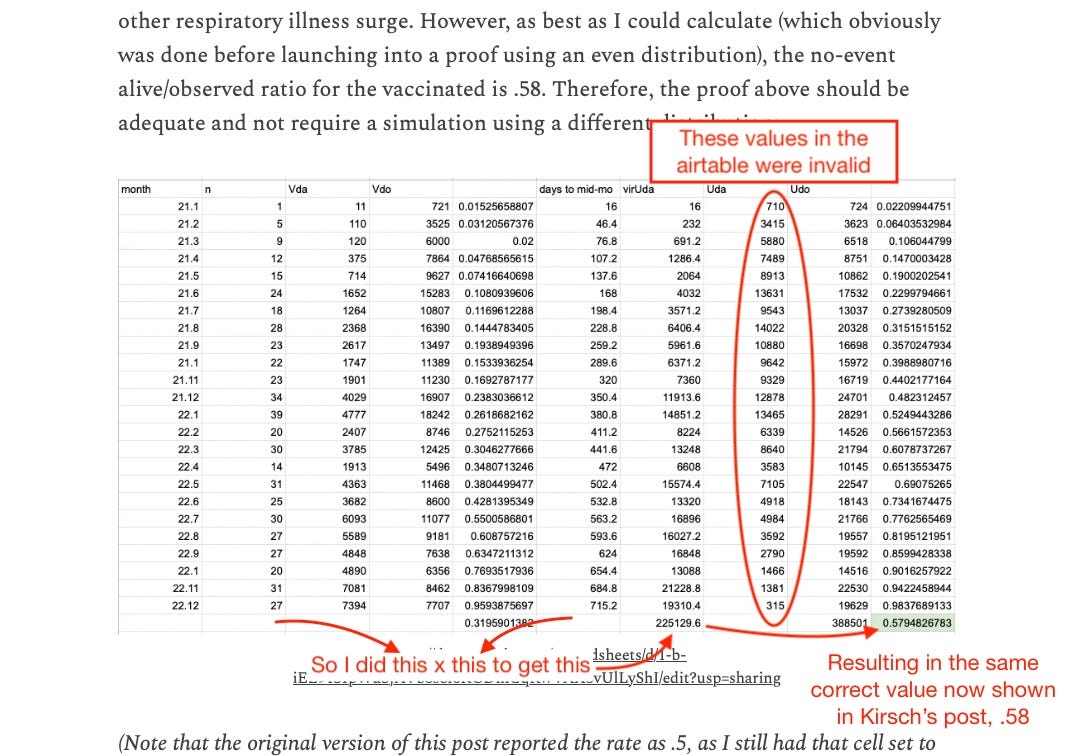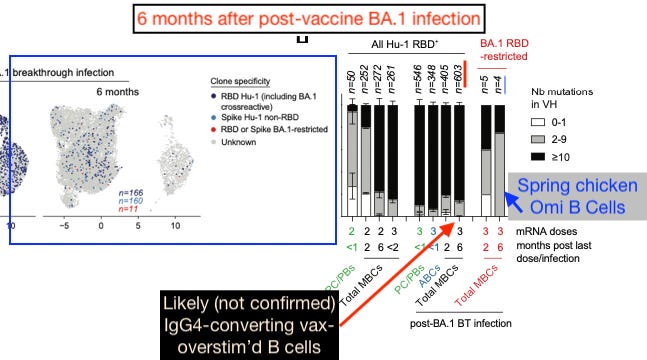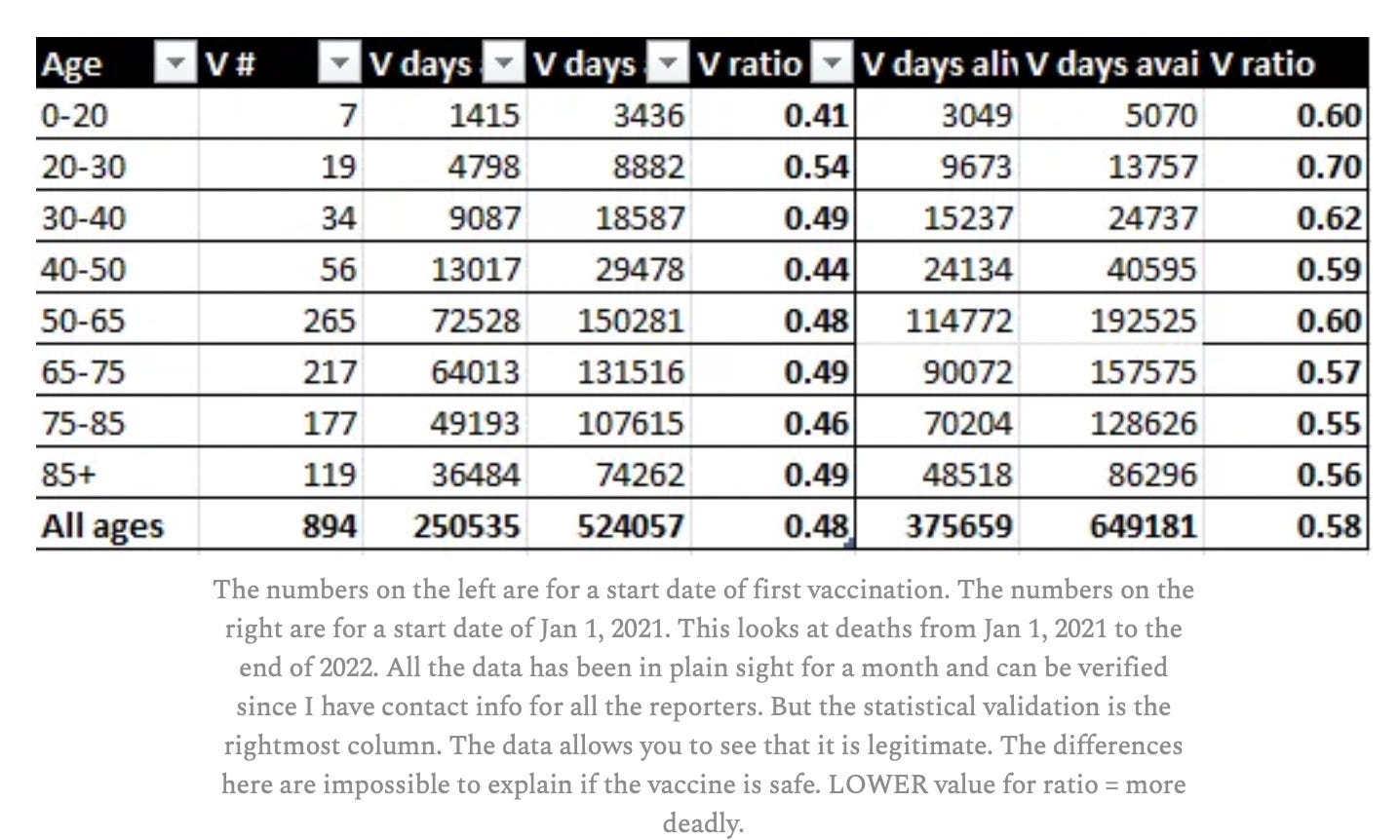Third post-Omicron infection study
A third study looking at B Cells 6 months after “breakthrough” Omicron (BA.1) infections has been added to the previous post. It resoundingly affirms the results of the other two:
*Update, February 2, 2023: A third paper has now been uploaded to preprint affirming the same result:
Despite the extreme redesign of the spike protein in BA.1 (and other Omicrons), infection does not prompt the generation of new (naive-derived) B Cell clones. Instead, vaccine-derived (and likely IgG4-converting) B Cells merely reshuffle and remodel to generate cross-reactive (but likely still IgG4-biased) antibody recognition.
The mRNA-vaccinated appear to be stuck with their original B Cell pool forever. But it’s ok. Having IgG4 antibodies to a version of the common cold for the rest of life is fine. I’m sure.
Brian’s proof against the Kirsch proof proved. “Hand waving” is not a rhetorical flaw.
On Monday, I pointed out flaws in the methodology of Kirsch’s freshly-published proof that the vaccine shortens lives. I also made evident a serious error in the function used to calculate the unvaccinated alive / observed ratio, but I didn’t highlight it in the text because I had so far only encountered the error in the data for the vaccinated, resulting in my correction seen below:

Kirsch has subsequently fixed the function for time alive (it was basically counting backwards before), resulting in an (accurate) recalculation of time alive / observed from January 1, 2021 in both the vaccinated and unvaccinated (without acknowledging that it also affected the vaccinated):
I also made an error in one of the columns (for the unvaxxed only).
Note that .48, the since-vaccinated time alive / observed ratio, reflects a revamp of the analysis using the date of first vaccination vs. the last. In replicating these new results, I was required to restrict date of first vaccination to after January 1, 2021, as using an earlier date leads to outlandish values due to a lot of incorrect vaccination dates in the survey.
This revamp results from Kirsch’s assertion that the only problem with his original design was using a “re-up-able” observed event. My proof explicitly and clearly applies to any event, absolute or “death-relative.” Kirsch is free to assert that my proof is not correct, but he has not demonstrated that it is not correct as far as I can ascertain.
Thus, the situation stands as follows:
Kirsch currently credits the same advisors who previously approved his method for “discovering” the problem that led to his rewrite of the post and downscale of the bet offer (now limited from $25,000 x 10 to $10,000 x 10):
The novel time-ratio method in this paper is sound, but certain restrictions apply to the metric that was chosen that I was subsequently made aware of after talking with Norman Fenton and Clare Craig. I am grateful to them for pointing out the limitations.
I discovered the “re-up” problem. Disagreeing that any event also creates the same no-win scenario as using a renewing event does not constitute discovery of the problem of using a renewing event.
Kirsch has offered “$5,000 to the first person who can prove that the data is biased and that the reality is that the vaccines are as safe as a placebo shot.” This is despite the fact that I have already shown the bias, in my reply to his update and re-construction of the original proof using a by-month-vaccinated adjustment. All that his method is showing is that observing any neutral event, including a placebo shot, would produce the same numbers.

I do not claim this meets the terms of his new offer. There is no way to use his data to show that the vaccine is as safe as a placebo; because of course it isn’t. Rather, I have shown that his method would make even a safe event appear to shorten life; so it isn’t revealing the harms of the vaccine, unfortunately.
What Brian would really like
I have shown that the work of discovering and documenting the harms of the Covid vaccines remains statistically difficult. This is why all vaccines get off the hook for their mauling of human health. That is satisfactory to me.
However, one element of Kirsch’s original framing of his data is worth highlighting:
To date, everyone who thinks they can debunk this has produced only handwaving arguments and no analysis.
Upon realizing the error in his original unvaccinated time alive function, and discovering that the unvaccinated die more quickly than the vaccinated relative to January 1, 2021, he wrote the following:
Secondly, for the unvaxxed, the ratio is going to be <.5 because people drop out and become vaccinated. Image if EVERYONE got vaccinated in Jan 2022. Then when looking at 2021 - 2022 death reports, it would “appear” like the unvaccinated all die off in the first year which would give a statistic of .25.
This is just hand-waving! Now that it turns out the unvaccinated deaths are 2021-heavy (due to Delta; again, I did not get around to tackling the error in the unvaccinated data until Tuesday but it was the same error that caused my re-simulation of the time alive for the vaccinated on Monday), resulting in a .42 time alive/observed ratio, now, he is willing to acknowledge a bias in the data?
Give me a break.
And frankly, this applies to everyone who has ever critiqued my critiques of “worry window,” “OAS,” and everything else, as hand-waving, nitpicking, etc.
Stop making excuses for flawed science.
With love,
Brian Mowrey, contrarian anti-Covid-vaxxer and science critic
If you derived value from this post, please drop a few coins in your fact-barista’s tip jar.










==> The mRNA-vaccinated appear to be stuck with their original B Cell pool forever. But it’s ok.
Is that kind of, sort of like original antigenic sin?
We've talked about this before, but this new imprint study does raise the question again why a previous vaccinated individual can produce new B-cells for the nucleus, but not unseen/changed parts of the spike protein.
One important aspect is that N-antibodies typically arrive only after one has cleared the infection. I mentioned this, as what was also left open is the question whether this reshuffle of existing B-cells only occurs if any older antibodies exist. As you have mentioned yourself 'AOS' is not a 'sin' as the old antibodies work fine. So there is also no need to create new ones.
But that would not mean, that if ever a new variant arrives in which the old types are all not effective, the body would not be able to create new B-cells. After all, that would result in large amounts of IgM's for proteins not seen before.
In fact we kind of know for sure that is the case. After all, what has been forgotten from the very early days of covid, is the research in how existing common cold immunity applied to covid. What was seen, is that we humans respond initially by producing large amounts of common cold antibodies, which are mostly non-effective (*). Still we all adapted back then, proving OAS wrong, as peopel infected then created Wuhan1 antibodies.
My guess is that the biochemical feedbacks causing a reshuffle vs produce new B-cells, only react this way when some effective response is mounted. But even then, the N-antibodies prove the body can learn and hence there must be a second factor at play here. I suggested that the changed spike sections may be too small or physically too close on the spikes to produce enough unique IgM's. Or other chemicals part of teh immune response interact here. (**). But I'm just speculating. It would hence be good to see, if truly no new B-cells are created for BA.1 unique proteins, even after a few months. We know also from early 2020 some people produce no antibodies at all, but did produce memory cells after beating covid.
*) There is one against the S2 protein that is, but only a minority of humans produces that. 2-4% in US/France, 10-15% in two African countries. But that is an interesting side issue.
**) The role of CD8 T+ cells is also interesting. Most of them are N-triggered, not spike triggered and may behave different, both in context of repeated infections as well as continuous boosting. This indicates separate learning mechanisms.